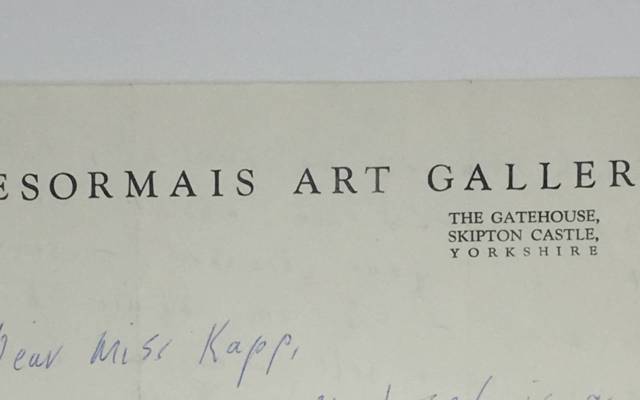
Curator Diary - Helen Kapp
15 Dec 2020
Dr Abi Shapiro, Assistant Curator at The Hepworth Wakefield, tells us about the visionary Helen Kapp, Director of Wakefield Art Gallery throughout the 1950s and ardent supporter and promoter of contemporary artists of her time.
In preparation for our latest exhibition, Vision and Reality: 100 Years of Contemporary Art in Wakefield, I spent many happy hours immersed in The Hepworth Wakefield’s archives researching some of the key figures who shaped the Wakefield Art Collection over the last century.
One of the people I enjoyed learning about most was Helen Kapp (1901–1978), the fourth director of Wakefield Art Gallery between 1951 to 1961. Not only was she the first woman in this role, but she led an innovative and creative exhibition programme underpinned by her strong belief that contemporary art and artists were integral in the ability to make sense of our everyday lives.
Helen Kapp initially trained as a painter and illustrator at the Slade School of Art in London where her brother Edmund Xavier Kapp was also a successful artist. Her first encounter with Wakefield came in 1941 when 10 of her own works featured in a group exhibition for London-based artists whose opportunities for displaying their work were diminished due to the bombings in the capital. Showing a parallel thirst for education and making art, Kapp also enjoyed writing, where she allowed her playful side to come out. In 1938 she co-wrote and illustrated the highly amusing Surrealist-inspired cookbook, Take Forty Eggs: A Comprehensive Guide to Cookery and Household Mismanagement that includes a chapter detailing how to cook without food. Other comical illustrated books include Toying with a Fancy (1948) where she introduced the book as one of “uninhibited graphic phantasy and fancy. The idea arose sparkling, out of a cloud of Drambuie on a crisp snowy Yorkshire night.” Kapp went on to write more serious educational books such as Enjoying Pictures (1975) designed to make art history more accessible to the general public.
The Hepworth Wakefield’s archives hold a substantial volume of Kapp’s sketchbooks and notebooks that show how she documented her life and work through lyrical drawings and descriptive diaristic prose. One highlight for me was a series of sketches of people made during a trip to Russia along with her attempts to learn the Cyrillic alphabet. The archives also hold a vast range of material about Kapp as a curator and director during her tenure in Wakefield, from letters between her and well-known modern artists such as L.S. Lowry, Keith Vaughan and Terry Frost, to passionate speeches for BBC Woman’s Hour, to her own hand-painted designs for exhibition catalogues. You can see these pieces of ephemera I selected from the archives on display in a section dedicated to the life and work of Helen Kapp in our latest exhibition Vision and Reality adjacent to the many pieces of art Kapp helped to acquire for Wakefield’s collection.
As a director, Kapp was responsible for building up the core of the mid-century British art collection in Wakefield and establishing a strong reputation for the gallery. Her ambitious exhibitions programme and acquisition policy celebrated significant contemporary artists, especially abstract painters and sculptors.
Kapp enabled displays and acquisitions of work by Prunella Clough, L.S. Lowry, Henry Moore, Keith Vaughan and Reg Butler among others. She gave solo shows to Patrick Heron and Alan Davie – the latter exhibition was visited by a young David Hockney who subsequently became inspired to explore abstraction in his own painting. She initiated the annual exhibition Modern Art in Yorkshire, that gave contemporary artists small solo shows; allowing living artists the opportunity to display multiple pieces of work was quite a radical policy for a regional museum at this time. Kapp also curated several large landmark exhibitions which attracted large crowds from across the UK and national press attention, including Vision and Reality (1956) that showed contemporary British art – from which our new exhibition takes its name. She also organised Living Today (1959), where eight architects were invited to redecorate the galleries as domestic spaces filled with contemporary design objects such as ceramics, textiles and furniture alongside contemporary abstract paintings, emphasising the importance of art in modern living.
I was delighted to discover that Kapp was an ardent champion of education in the programme at Wakefield Art Gallery as she was a fundamental role in connecting young people with culture. In local newspapers she expressed frustration that art history was not part of the school curriculum and worked to involve regional galleries in local schools’ activities. Kapp was closely involved with The Education Resource Service that began in the 1950s which was a UK-wide scheme to give children a chance to learn through a direct experience of art and craft. Kapp was part of the West Riding committee who shortlisted contemporary works by artists around the country that were then chosen for short-term display by teachers from over 1500 primary schools across the country.
My research into Helen Kapp reveals a visionary director with a deep sense of humanity and purpose who placed education, access to art, and supporting contemporary artists at the centre of her vision for Wakefield. While installing this exhibition about the collection during lockdown in November, Kapp was a constant source of inspiration for continuing this legacy in Wakefield in the future. As we eagerly await the moment when we can to reopen our galleries and this exhibition to the public, the enriching and centring role Kapp saw for art in our lives has never seemed so profound as we grapple to make sense of the strange circumstances in which we find ourselves.









